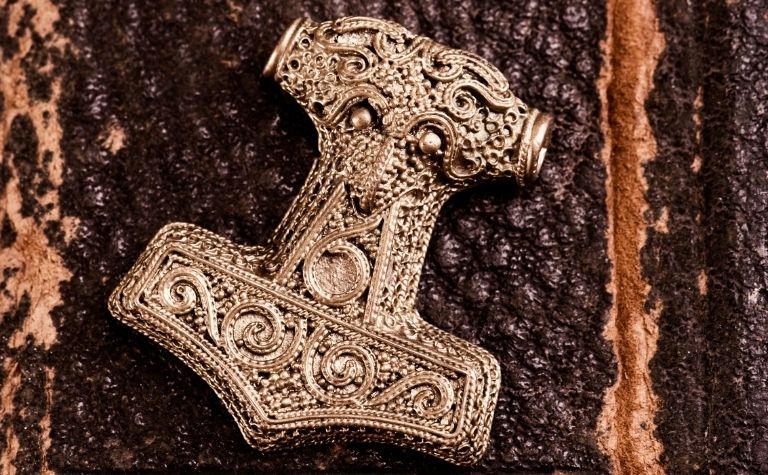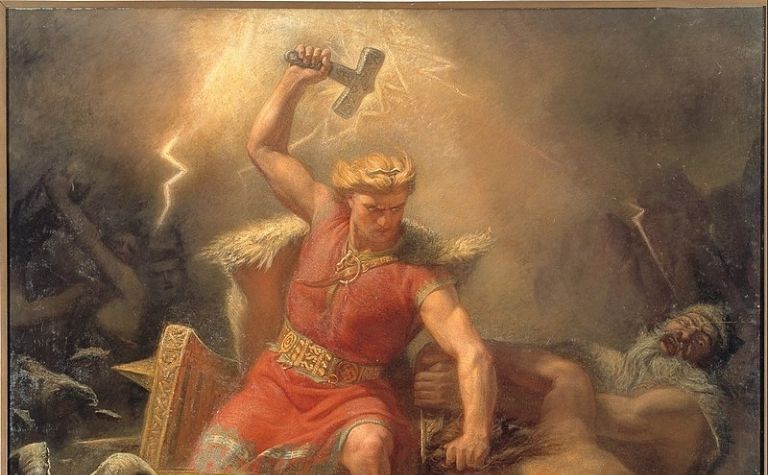Records of the ancient Norse religion are sparse. Stories from Norse mythology were not written down until after much of Scandinavia had converted to Christianity, and their temples and artifacts were destroyed.
However, there is little doubt of the importance and prevalence of Thor in the ancient Norse religion.
The Vikings believed Thor was a sky god and their constant protector against chaos. He is often called “the god of thunder,” and he is indeed associated with storms and weather.
He and his wife, Sif, blessed the land with fertile crops, and Thor’s hammer could consecrate marriages.
Read on to learn more about what Thor signified in the Viking culture and discuss different aspects of his influence.
Also, see Norse Thor vs. Marvel Thor: What’s the Difference? to learn more.

Who Was Thor to the Vikings?
The Vikings did not look to the gods for moral approval or omnipotent guidance. They used myths about the gods to explain the world as they saw it.
Instead of being arbiters of morality, the Norse gods were forces holding the universe together.
Thor’s role was to protect the orderly worlds of the gods and man from the chaotic giants beyond.
The name “Thor” literally means “thunder,” and his hammer, Mjollnir, is similar to the Norse word for “lightning.”
But Thor’s role in Norse religion goes far beyond creating thunderclaps and lightning strikes.
The Vikings believed Thor was the living embodiment of thunder. He was a god of the common people, and he was a role model for warriors. Thor protected all of humanity and blessed their farmlands, marriages, and temples.
With the help of his hammer, Thor could drive out evil and make a thing or place holy. Mjollnir brought dead animals back to life just as easily as it smashed the skulls of giants.
Thor wrought destruction and blessings in equal measure.
Unlike Odin, his father, Thor did not favor the nobility and scholars. He was a god to whom the average Viking could relate.
Thor did not use arcane knowledge, trickery, or prophecy to win battles. Instead, he used his willpower, bravery, and strength.
The Vikings viewed the universe as a chaotic place, but Earth (or Midgard) and Asgard, the realm of the gods, were orderly thanks to Thor’s protection.
Without Thor to fight against the giants, humanity and the gods would fall into chaos.
Also, see Was Thor a Real Person? to learn more.

How Did the Vikings Worship Thor?
Even though not much record of the Vikings’ religious practices has survived today, it is clear that they included Thor in their everyday lives.
Amulets in the shape of Thor’s hammer dating back to the Viking age have been found all over Scandinavia.
There are also some accounts of temples dedicated to Thor where the Vikings worshipped.
The Vikings worshipped Thor through animal sacrifices, symbols of his hammer, and building statues in his honor.
Unfortunately, almost none of those statues survived Norway’s conversion to Christianity.
Though the Christians destroyed nearly all the temples to Thor around the 12th century, smaller pieces of archeological evidence remain.
Amulets of Mjollnir were a form of worship, a way to invoke Thor in daily life.
The Vikings used this symbol to bless weddings, business contracts, births, and funerals.
A Norse sailor could wear an amulet of Thor’s hammer for protection at sea, and a warrior, for strength in battle.
The Vikings also kept small stones, sometimes called “thunderstones,” as charms for protection. These stones were made from flint and could spark a fire, an homage to Mjollnir’s ability to create lightning and thunder.
The edges of the thunderstones were chipped as if the stones had fallen from the sky.
Archeologists have found thunderstones in many Viking graves.
The few surviving descriptions of temples to Thor suggest that these places of worship were grand and ornate.
One written account from the 14th century describes a temple to Thor with a massive moving statue. The statue featured a rope that, when pulled, could create the sound of a thunderclap.
There are also written records of ritual animal sacrifices performed at Thor’s temples. Once every nine years, the Vikings sacrificed male animals and hung them from holy trees.
The Vikings did not view Thor as a god that they served unconditionally or as a god they needed to please.
They made sacrifices to Thor, and in return, their god granted them safety at sea and a bountiful harvest.
Even after Christianity began to spread throughout Scandinavia, Thor worship continued.
Many Vikings still clung to their religion or tried to practice both Norse paganism and Christianity.
It was only when King Olaf Tryggvason tortured and killed pagans that the Vikings firmly, even if nominally, converted to Christianity.
Also, see How Did Thor Get His Hammer? to learn more.
Do People Still Believe in Thor Today?
The old Norse religion, called Asatro or Asatru, is practiced today by thousands of people across Iceland, Denmark, Norway, and other European countries.
Asatru was made an official religion in the 1970s and has grown steadily ever since.
Because of the lack of historical records from the Vikings, it is difficult to determine how similar Asatru’s revival is to the original practice.
Some practitioners of Asatru do believe in Thor, though many others do not.
These modern pagans believe in the gods as metaphors and useful storytelling devices rather than literal beings who inhabit Asgard and cause meteorological phenomena.
Practicing Asatru is a way for Scandinavians to reject the Christianity that swept through their countries a millennia ago. It also allows them to honor their ancestry and reconnect with centuries of history.
Asatru is not a strictly structured religion, and interpretation of the ancient Norse texts is left to individuals.
While some believers may read Norse mythology as literal, others consider Thor a role model for courage and strength, not a living person.
Followers of Asatru may pray to the Norse gods for fertility, protection, and blessings, much like the Vikings once did.
They meditate, make sacrifices, and live mindfully of how their actions affect others. Asatru is largely a peaceful religion, focusing on nature, ancestors, fertility, and kindness.
Conclusion
The Vikings could relate to Thor. They strove to be like him and prayed to him for protection, just as their descendants do today.
